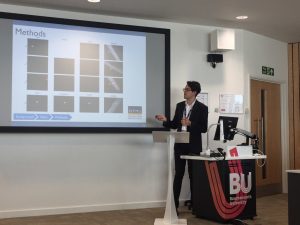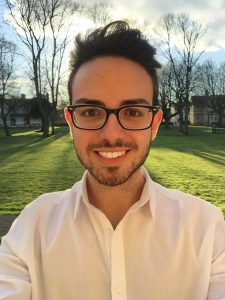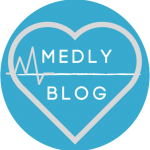If someone had told me five years ago that I would undertake my medical training in the UK, I would have never believed them. The real life-changing opportunity came when I applied for an exchange year abroad in 2013. From that moment onwards, studying medicine here became a tangible option. There are endless differences between British and Italian medical schools, but I would have never guessed the myriad of new opportunities I would be offered at HYMS. I have always been the type of person who likes keeping busy and active, and I have therefore been involved from day one in university life. Alongside being a student representative and ambassador, and being involved in a few student societies, I have also pursued my interest in research.
 My research journey began last year with my tutor, Dr Antonios Matsakas, at the Centre for Cardiovascular and Metabolic Research (CCMR). I could not be more grateful for the welcoming and mentally stimulating environment in which I found myself. Thanks to the INSPIRE grant I was awarded, I joined Antonios’ research team in April 2016 to investigate the pathophysiology of skeletal muscle myopathies due to peripheral vascular disease in experimental models. The project was meant to be a short summer project, but I have been on board ever since thanks to my enthusiasm for the subject and good relationship with the lab team.
My research journey began last year with my tutor, Dr Antonios Matsakas, at the Centre for Cardiovascular and Metabolic Research (CCMR). I could not be more grateful for the welcoming and mentally stimulating environment in which I found myself. Thanks to the INSPIRE grant I was awarded, I joined Antonios’ research team in April 2016 to investigate the pathophysiology of skeletal muscle myopathies due to peripheral vascular disease in experimental models. The project was meant to be a short summer project, but I have been on board ever since thanks to my enthusiasm for the subject and good relationship with the lab team.
My project focused on peripheral arterial disease, such as atherosclerosis, and the results of this on peripheral skeletal muscles. Obese individuals have shown histological evidence of infiltration of lipids in various types of tissue, such as muscles, liver, and bone. This infiltration process leads to an impairment of the normal cellular machinery resulting in the production of reactive oxygen species, mitochondrial deficits and high oxidative stress, all of which may eventually cause cell damage or death. Muscle cells are incapable of mitosis, but they can grow, heal, be repaired and be replaced by means of muscle-specific stem cells called satellite cells. These are found underneath the basement membrane of the myofibres, and are usually quiescent in normal muscles. If an injury occurs, either chemical or mechanical, this will cause them to become activated and start proliferating; at this stage, satellite cells can either regress to the state of quiescence or become committed to differentiation into future mature myofibres. We have identified each stage of this process by means of primary antibody staining for genetic markers which are expressed in the cell nucleus at specific time points. Using fluorescent microscopy, we then quantified the number of satellite cell nuclei per myofibre, and the collected data has now been analysed.
My typical week would involve a couple of days spent in the lab, focusing on my studies alongside lots of preparation for the experiments during the remaining days. I have not studied a previous degree and have done little science biopracticals at high school; I therefore needed to undertake some reading in my free time in order to understand the science behind our project, especially at the very beginning. I must admit that it was not easy at first, but I found myself increasingly interested in the papers I read, and became more confident at understanding and appraising papers with time. We held ‘journal clubs’ on a weekly basis where we would discuss papers relevant to out projects, and I believe this was essential to my insight and knowledge of what I was doing in the lab.
From our work together, we have produced some abstracts which have been accepted for presentations. I have already attended a poster presentation at the Academic Training in Undergraduate Medicine (ATRIUM)[1] National Conference in Edinburgh, and have given an oral presentation at the British Conference of Undergraduate Research (BCUR)[2] in Bournemouth in late April 2017. I am now looking forward to presenting our work at the International Academic and Research Conference (IARC)[3] in Manchester, in August. I cannot describe how honoured and proud I am to be able to present our research at an international level.
I am extremely grateful of the help and support I have received from Antonios and the PhD students I have worked with: Peggy Sfyri, Sandrine Verpoorten and David Scully. This has been an amazing and interesting journey, and I would highly recommend it to anyone. At one time, I would have never considered a career in academia, but I am now excited and thrilled at the opportunity of combining my interest in research with my passion for surgery. However, while keeping all options and paths still open, I can look back and see that it all begun with my INSPIRE project. You do not have to be deeply interested in research to do a summer project like INSPIRE, which could open the door to new perspectives.
Dr Antonios Matsakas said: ‘I am delighted to have hosted in my lab a highly motivated and outstanding MBBS student. Vassili is a charismatic student who ran the extra mile and engaged with research questions in an excellent way. We are committed to supporting student learning experience, and support their professional development. I am thrilled that Vassili has disseminated research outputs from his project at national and international events and has improved his CV through research in my laboratory.’
References
[1] Crispi V, Sfyri P, Verpoorten S, Matsakas, A. (2017). Poster: The ATRIUM 9th National Undergraduate Conference: Research in action, Edinburgh, 04/02/2017
[2] Crispi V, Sfyri P, Verpoorten S, Matsakas A. (2017). Oral presentation: British Conference of Undergraduate Research, Bournemouth, 25-26/04/2017
[3] Crispi V Sfyri P, Verpoorten S, Matsakas A. (2017). Oral presentation: 7th International Academic and Research Conference, Manchester, 05/08/2017
 Vassili Crispi is a third year medical student at HYMS with a keen interest in neurology, neurosurgery and research. He is president of HYMS NeuroSoc and works along other societies, too. In his spare time he enjoys reading, listening to music, playing his clarinet and saxophone, and travelling.
Vassili Crispi is a third year medical student at HYMS with a keen interest in neurology, neurosurgery and research. He is president of HYMS NeuroSoc and works along other societies, too. In his spare time he enjoys reading, listening to music, playing his clarinet and saxophone, and travelling.

